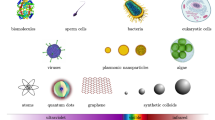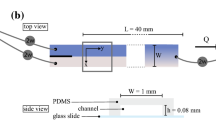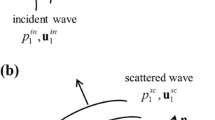Abstract
This article introduces a theoretical analysis of submerged nanoparticle manipulation in liquid medium using the atomic force microscopy, and gives a review of the major differences between dry and submerged manipulation processes. In this regard, the manipulation is modeled by adding the influences of the hydrodynamic forces surface forces to the manipulation model in dry air. Then, the pushing of a gold nanoparticle of 50-nm radius on a silicon substrate at a velocity of 100 nm/s is simulated, and the dynamic behaviors of the tip and nanoparticle are investigated. The results show that, in water (as compared to air), the required manipulation force and time for nanoparticle sliding and rolling increase by 3.5 and 6.5%, for sliding and 2 and 4.3% for rolling, respectively. Also, in liquids with different viscosities, the critical values related to sliding and rolling have a maximum variation of 17 and 32% for the manipulation time, and 6 and 22% for the manipulation force, respectively, as compared to the critical values related to particle manipulation in air. Moreover, for various submerged lengths of the cantilever in water, the critical values related to sliding and rolling show a maximum time variation of 9 and 10.5%, and 7 and 7.2% (for the manipulation force), respectively. Qualitative comparisons between the obtained results and those of the existing experimental investigations show the advantages of the liquid medium for the manipulation purposes.








Similar content being viewed by others
Abbreviations
- R t :
-
Tip radius
- L :
-
Length of cantilever
- w :
-
Width of cantilever
- t :
-
Thickness of cantilever
- H :
-
Probe height
- R P :
-
Radius of nanoparticle
- P T :
-
Pushing force
- ψ :
-
Pushing force angle
- K y :
-
Lateral spring constant of the cantilever
- Kc :
-
Normal spring constant of the cantilever
- \( K_{\theta } \) :
-
Torsional spring constant of the cantilever
- F y, F z :
-
Bending forces of cantilever
- M θ :
-
Torsional torque of cantilever
- v :
-
Shear force
- F Y , F Z :
-
Vertical and horizontal forces of the probe tip
- θ :
-
Torsion angle of cantilever
- y P :
-
Horizontal deformation of cantilever
- z P :
-
Vertical deformation of cantilever
- a :
-
Radius of the contact area
- A :
-
Contact area
- δ :
-
Indentation depth
- K :
-
The reduced elasticity modulus between two contacted materials
- F :
-
Normal force in contact area
- f t, f s :
-
Tip–particle and particle–substrate frictions
- F t, F s :
-
Tip–particle and particle–substrate normal forces in contact area
- R ′ :
-
Effective radius of two contacted surfaces
- E :
-
Young’s modulus
- G :
-
Shear modulus
- ν :
-
Poisson’s coefficient
- ω :
-
Work of adhesion (energy per unit area of two flat surfaces)
- \( \gamma \) :
-
Surface energy
- \( \varphi_{0} \) :
-
Initial deformation of cantilever
- \( \varphi \) :
-
Probe/nanoparticle Contact angle
- Z P0 :
-
Initial normal deflection
- m :
-
Constant parameter depending on the tip geometry
- μ and τ :
-
Friction constants
- τ :
-
Shear strength of the particle/substrate or tip/particle contact area
- μ d :
-
Friction coefficient (stationary state)
- μ s , μ r :
-
Sliding/rolling friction coefficient
- τ s, τ r :
-
Shear strength of contact area in the sliding/rolling operation
- d :
-
Critical rolling displacement
- σ :
-
The mean distance between neighboring atoms
- P cr :
-
Critical force (tip force on the particle to overcome adhesion forces)
- t cr :
-
Critical time (the moment nanoparticle begins to move on the substrate)
- V sub :
-
Substrate velocity
References
Butt HJ, Cappella B, Kappl M (2005) Force measurements with the atomic force microscope: technique, interpretation and applications. J Surf Sci Rep 59:1–152
Chan DYC, Mitchell DJ (1983) The free energy of an electrical double layer. J Colloid Interface Sci 95:193–197
De Gennes PG (1987) Polymers at an interface: a simplified view. J Adv Colloid Interface Sci 27:189–209
Gauthier M, Nourine M (2007) Capillary force disturbances on a partially submerged cylindrical micromanipulator. Robot IEEE Trans 23:600–604
Gauthier M, R′egnier S, Rougeot P, Chaillet N (2006) Forces analysis for micromanipulations in dry and liquid media. J Micromechatron 3(34):389–413
Israelichvili J (1991) Intermolecular and surface forces, 2nd edn. Academic Press, New York
Jones RE, Hart DP (2005) Force interactions between substrates and SPM cantilevers immersed in fluids. J Tribol Int 38:355–361
Korayem MH, Zakeri M (2009) Sensitivity analysis of nanoparticles pushing critical conditions in 2-D controlled nanomanipulation based on AFM. J Adv Manuf Technol 41:714–726
Liang Y, Hilal N, Langston P, Starov V (2007) Interaction forces between colloidal particles in liquid: theory and experiment. J Adv Colloid Interface Sci 134:151–166
Mahboobi SH, Meghdari A, Jalili N, Amiri F (2009) Precise positioning and assembly of metallic nanoclusters as building blocks of nanostructures: a molecular dynamics study. Physica E 42:182–195
Moshfegh A, Shams M, Ahmadi G, Ebrahimi R (2010) A new expression for spherical aerosol drag in slip flow regime. J Aerosol Sci 41:384–400
Neto Ch, Evans DR, Bonaccurso E, Butt H-J, Craig VS (2005) Boundary slip in Newtonian liquids: a review of experimental studies. Rep Prog Phys 68:2859–2897
Resch R, Lewis D, Meltzer S, Montoya N, Koel BE, Madhukar A, Requicha AAG, Will P (2000) Manipulation of gold nanoparticles in liquid environments using scanning force microscopy. J Ultramicrosc 82:135–139
Schaaf SA, Chambre PL (1961) Flow of rarefied gases. Princeton University Press, Princeton
Senturia SD (2001) Microsystem design. Kluwer Academic Publisher Groups, Dordrecht
Sitti M, Hashimoto H (2000) Force controlled pushing of nanoparticles: modeling and experiments. IEEE/ASME Trans Mechatron 5:199–211
Spurk HJ, Aksel N (2008) Fluid mechanics, 2nd edn. Springer-Verlag, Berlin
Tafazzoli A, Sitti M (2004) Dynamic behavior and simulation of nanoparticles sliding during nanoprobe-based positioning. In: Proceedings of IMECE’04 2004 ASME International Mechanical Engineering Congress, Anaheim
Verwey EJW, Overbeek JTG (1948) Theory of the stability of lyophobic colloids. Elsevier Publishing Inc., New York
Author information
Authors and Affiliations
Corresponding author
Rights and permissions
About this article
Cite this article
Korayem, M.H., Motaghi, A. & Zakeri, M. Dynamic modeling of submerged nanoparticle pushing based on atomic force microscopy in liquid medium. J Nanopart Res 13, 5009 (2011). https://doi.org/10.1007/s11051-011-0482-0
Received:
Accepted:
Published:
DOI: https://doi.org/10.1007/s11051-011-0482-0




